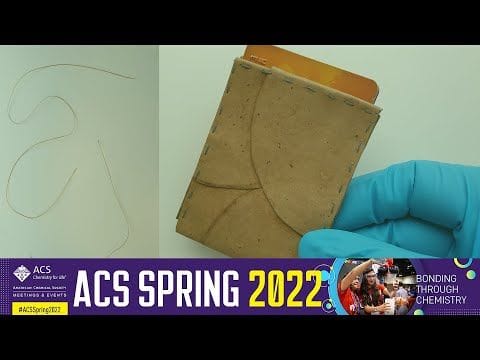Mushrooms do have a leathery feel, but Akram Zamani took this to the extreme. Using Rhizopus delemar, a fungus usually found on decaying food, Zamani’s group fed it bread and harvested chitin and chitosan fibers from its cells. These fibers were then spun into strings for use as sutures or wound healing mats.

Mushrooms do have a leathery feel, but Akram Zamani took this to the extreme. Using Rhizopus delemar, a fungus usually found on decaying food, Zamani’s group fed it bread and harvested chitin and chitosan fibers from its cells. These fibers were then spun into strings for use as sutures or wound healing mats. Additionally, the jelly-like residue harvested from the cell walls of the fungi could be spread out and dried into sheets that feel and perform like paper and leather. While biobased replacement textiles are growing in popularity, most of the technology for producing them still relies on petroleum-based feedstocks. The major advantage of the fungal-based textile is the feedstock: food waste. Additionally, what often takes several days in a fermenter or by other fungi only requires about two days of fungal growth because the R. delemar is water based and grows much faster. This type of submerged cultivation is fast and environmentally friendly, turning food waste into value-added textiles.
News briefing from the meeting:
Video media briefing:
Recent ACS Publications articles on this topic:
Uncovering the Mechanical, Thermal, and Chemical Characteristics of Biodegradable Mushroom Leather with Intrinsic Antifungal and Antibacterial Properties
Jenniffer Bustillos, Archana Loganathan, Richa Agrawal, Brittany A. Gonzalez, Marcos Gonzalez Perez, Sharan Ramaswamy, Benjamin Boesl, and Arvind Agarwal
DOI: 10.1021/acsabm.0c00164
Sustainable materials make a play for the leather market
A new crop of biobased-material makers aims to displace chrome-tanned cowhide
Craig Bettenhausen
DOI: 10.1021/cen-09908-feature3
Fungi, enzymes, and closed-loop catalysis offer environmental, economic gains in manufacturing and recycling
Mairin B. Brennan
DOI: 10.1021/cen-v076n012.p039
Chitosan Natural Polymer Material for Improving Antibacterial Properties of Textiles
Jianhui Li, Xiao Tian, Tao Hua, Jimin Fu, Mingkin Koo, Wingming Chan, and Tszyin Poon
DOI: 10.1021/acsabm.1c00078
Physicochemical Properties and Bioactivity of Fungal Chitin and Chitosan
Tao Wu, Svetlana Zivanovic, F. Ann Draughon, William S. Conway, and Carl E. Sams
DOI: 10.1021/jf048202s
Recent publications by this group:
Extraction and Precipitation of Chitosan from Cell Wall of Zygomycetes Fungi by Dilute Sulfuric Acid
Akram Zamani, Lars Edebo, Björn Sjöström∥, and Mohammad J. Taherzadeh
DOI: 10.1021/bm700701w
Determination of Glucosamine in Fungal Cell Walls by High-Performance Liquid Chromatography (HPLC)
Marzieh Mohammadi, Akram Zamani, and Keikhosro Karimi
DOI: 10.1021/jf303488w
Effects of Partial Dehydration and Freezing Temperature on the Morphology and Water Binding Capacity of Carboxymethyl Chitosan-Based Superabsorbents
Akram Zamani and Mohammad J. Taherzadeh
DOI: 10.1021/ie100257s
